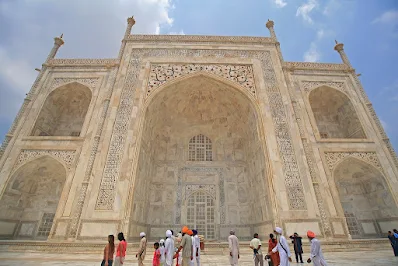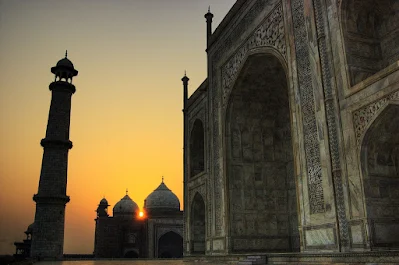1. The Love Story That Inspired the Taj MahalAt the heart of the Taj Mahal’s creation lies a tragic yet beautiful love story. Shah Jahan, born as Prince Khurram in 1592, was the grandson of the legendary Mughal emperor Akbar the Great. In 1607, he met Arjumand Banu Begum, later known as Mumtaz Mahal, and instantly fell in love. Five years later, in 1612, they married, and their union was marked by deep affection and companionship. Mumtaz Mahal became Shah Jahan’s most trusted confidante and companion, accompanying him on military campaigns and assisting him in matters of governance. 1.1 The Sudden Loss of Mumtaz MahalIn 1631, during the birth of their 14th child, Mumtaz Mahal tragically passed away, leaving Shah Jahan heartbroken. Stricken with grief, the emperor was said to have secluded himself from public life for an extended period, mourning the loss of his beloved wife. To honor her memory and ensure that her beauty and legacy would be immortalized, Shah Jahan embarked on the creation of the Taj Mahal, a tomb that would stand as an eternal symbol of his love for Mumtaz Mahal.1.2 The Significance of Mumtaz Mahal’s InfluenceMumtaz Mahal was more than just the emperor’s wife; she was a symbol of purity, loyalty, and elegance. Her influence on Shah Jahan’s life was profound, and her untimely death left a void that he sought to fill through the creation of a monument worthy of her beauty and grace. The Taj Mahal became not only a mausoleum but a testament to the undying love between Shah Jahan and Mumtaz Mahal.2. The Architectural Marvel of the Taj MahalThe Taj Mahal’s architectural grandeur is unparalleled, blending Persian, Islamic, and Indian architectural styles into one cohesive and harmonious structure. The project, which began in 1632, took approximately 22 years to complete, with the help of over 20,000 artisans, laborers, and skilled craftsmen from all over the empire. 2.1 The Use of White MarbleOne of the most striking features of the Taj Mahal is its gleaming white marble facade. The marble was sourced from Makrana, Rajasthan, and is known for its high quality and durability. The choice of white marble not only symbolizes purity and spirituality but also reflects changing hues depending on the time of day. In the early morning, the monument appears pinkish, while at sunset, it glows a golden hue, creating a mesmerizing spectacle for visitors.2.2 The Calligraphy and Decorative InlaysThe Taj Mahal is adorned with intricate calligraphy, primarily in Arabic, which features verses from the Quran. These inscriptions, meticulously carved into the marble, are a tribute to the Islamic faith and add to the spiritual ambiance of the mausoleum. Additionally, the walls and ceilings are decorated with stunning inlay work using precious and semi-precious stones like jade, turquoise, lapis lazuli, and onyx. These inlays form delicate floral patterns, adding a touch of elegance to the otherwise stark white marble.2.3 The Symmetry of the StructureThe Taj Mahal’s design is famous for its perfect symmetry, a hallmark of Mughal architecture. The central dome is flanked by four smaller domes, and minarets stand at each corner of the platform. The symmetry extends to the gardens, fountains, and reflecting pool, all of which contribute to the sense of balance and harmony. The careful attention to proportion and geometry makes the Taj Mahal not only visually stunning but also architecturally perfect.3. The Symbolism of the Taj Mahal’s DesignBeyond its aesthetic beauty, the Taj Mahal’s design is rich with symbolism. Every aspect of the structure was meticulously planned to convey deeper meanings related to love, death, and the afterlife. 3.1 The Central Dome: A Metaphor for HeavenThe central dome, rising to a height of 73 meters (240 feet), represents the heavens or paradise. According to Islamic tradition, paradise is a place of eternal peace and beauty, and the Taj Mahal’s dome is a metaphor for the celestial afterlife that Shah Jahan wished for his wife. The finial atop the dome combines Islamic and Hindu elements, reflecting the syncretism of Mughal culture.3.2 The Gardens as an Allegory for ParadiseThe Taj Mahal is surrounded by lush, meticulously manicured gardens known as charbagh. These gardens are divided into four quadrants, representing the four rivers of paradise mentioned in Islamic texts. The inclusion of water channels and fountains not only enhances the monument’s visual appeal but also serves as a reminder of the eternal life that Shah Jahan hoped for Mumtaz Mahal. The reflecting pool, which mirrors the image of the Taj Mahal, symbolizes the merging of the earthly and the divine.4. The Construction and Labor Behind the Taj MahalThe construction of the Taj Mahal was a massive undertaking that required vast resources, skilled labor, and innovative engineering techniques. 4.1 The WorkforceTo bring Shah Jahan’s vision to life, an estimated 20,000 workers were employed. Architects, stonecutters, calligraphers, and artisans from across the Mughal Empire and beyond contributed their expertise. Master craftsmen from Persia, Central Asia, and Europe were also involved, ensuring that the monument would be a blend of various artistic influences.4.2 Innovative EngineeringThe construction of the Taj Mahal required innovative solutions to overcome several engineering challenges. For example, the main dome’s weight was carefully distributed using an internal support system of arches, preventing it from collapsing. Additionally, the minarets were deliberately designed to tilt slightly outward, ensuring that in the event of an earthquake, they would fall away from the central dome rather than onto it.5. The Impact and Legacy of the Taj MahalSince its completion in 1653, the Taj Mahal has had a lasting impact on both Indian and global culture. It has become a symbol of India’s rich history and architectural brilliance, attracting millions of visitors each year. 5.1 A UNESCO World Heritage SiteIn 1983, the Taj Mahal was designated a UNESCO World Heritage site in recognition of its cultural and historical significance. This designation ensures that the monument is preserved for future generations, maintaining its status as a global icon.5.2 Influence on Modern ArchitectureThe influence of the Taj Mahal extends beyond its time, inspiring architectural styles and designs in India and around the world. Several buildings have drawn inspiration from its distinctive dome, arches, and intricate detailing, making it a timeless masterpiece that continues to inspire.5.3 A Symbol of Eternal LoveFor many, the Taj Mahal remains a symbol of eternal love and devotion. Its backstory, rooted in the deep affection between Shah Jahan and Mumtaz Mahal, has touched the hearts of countless people around the world. The monument’s romantic allure makes it a popular destination for couples and honeymooners who want to experience the beauty of one of the greatest love stories ever told.Conclusion: The Eternal Legacy of the Taj MahalThe Taj Mahal is more than just an architectural marvel; it is a symbol of love, loss, and the enduring legacy of the Mughal Empire. Built in memory of Mumtaz Mahal, this stunning monument has stood the test of time, captivating the hearts of millions with its unparalleled beauty and profound history. Its intricate design, attention to detail, and symbolic meaning make it one of the world’s most cherished landmarks. As you walk through the gardens, gaze upon the marble facade, and stand before the central dome, you are not just witnessing a structure but experiencing the emotion and artistry that went into creating this masterpiece. The Taj Mahal is a true testament to the power of love, art, and human ingenuity, a timeless symbol of India’s rich cultural heritage. The sun sets behind the Taj Mahal in Agra, casting a warm glow over the iconic monument and its serene surroundings. The Taj Mahal in Agra, India, showcasing its iconic white marble architecture and serene surrounding gardens. The Taj Mahal in Agra, India, showcasing its stunning white marble architecture against a clear blue sky. The Taj Mahal silhouetted against a vibrant sunset, showcasing its majestic architecture and serene reflection in the water. The Taj Mahal, a stunning white marble mausoleum, stands majestically against a clear blue sky, symbolizing eternal love. The Taj Mahal, a stunning white structure adorned with multiple towers, stands majestically against the sky. |
The True Story Behind the Taj Mahal: Love, Legacy, and History
Golden Words (Quotes)
- 6 Islamic Kalma 6
- Ahadees Mubarika. 18
- Akhirat (آخرت) 2
- Ali A.S quotes 1
- Allah ka Khouf 1
- Allah ki Pehchan ( اللہ کی پہچان ) 1
- Allah ky bandy (اللہ کے بندے) 2
- Allah se Doori ( اللہ سے دوری ) 1
- Anger (غُصّہ) 3
- Apne Paraye ( اپنے پرائے) 2
- Aqwal e Zareen in Urdu 1
- Azmaish ( آزمائش ) 1
- Bad (بُرا ) 2
- Beauty ( خوبصورت ) 1
- Begging ( بھیک ) 1
- Betrayal (دھوکہ) 2
- Bismillah Wallpapers 1
- Bulleh Shah poetry 2
- Charity. Sadqa ( صدقہ ) 1
- Cheap Hotel Near Haram 1
- Companionship. Sohbat ( صحبت ) 1
- Contentedness (قناعت) 1
- Darood Sharif ke Fazail ( درود شریف کے فضائل) 1
- Death ( موت ) 1
- Deed ( عمل ) 2
- Desire ( خواہش ) 1
- Dr. Muhammad Tahir ul Qadri 5
- Ego انا اور نفس 5
- Faith on Allah 1
- Faith(ایمان) 1
- Friendship ( دوستی ) 4
- Ghar e Hira 1
- Give For Allah(اللہ کی راہ میں خرچ کرنا) 1
- Graves of Prophet 1
- Greed ( لالچ ) 1
- Hazrat Abu Bakr Siddique (RA) 3
- Hazrat Ali (RA) Quotes 21
- Hazrat Baba Bulleh Shah 8
- Hazrat Muhammad PBUH Quotes 22
- Hazrat Sheikh Saadi 1
- Hazrat Umer Farooq (RA) 9
- Hijab ( پردہ ) 1
- Human Being ( انسان ) 1
- Husband and Wife ( شوہر اور بیوی ) 3
- Islamic quotes on Shab e Barat 1
- Kindness ( بھلا ئی ) 3
- LIE (جھوٹ) 1
- Madina wallpapers 1
- Malice ( کینہ ) 1
- Martyrdom (شہادت) 1
- Momin ( مومن ) 1
- Monafqat (منافقت ) 1
- Mother (ماں) 1
- Muhammad PBUH Name Miracles 1
- Pious (متقی) 1
- Prophet Muhammad PBUH quotes 1
- Prostrate ( سجدہ ) 1
- Rizq e Halal (رزقِ حلال) 1
- Secrecy ( پردہ پوشی، راز ) 1
- Self-Improvement (خود بہتری ) 2
- Today and Tomorrow (آج اور کل ) 1
- Truth ( حق سچ ) 1
- Well-wisher(خیر خواہ) 1
- Wisdom. Hikmat ( دانائی ، حکمت ) 4
- beauty of Islam 1
- darood pak ki fazilat 1
- golden words in urdu 2
- paradise ( جنت ) 1
- قحط 1
Search This Blog
Most Popular

Learn the 6 Islamic Kalmas & Download Kalma Pictures (Urdu & English)
February 14, 2011

Darood Sharif ki Fazilat Urdu, Durood e Pak ki Fazeelat
March 01, 2017

The True Story Behind the Taj Mahal: Love, Legacy, and History
February 14, 2011







0 Comments